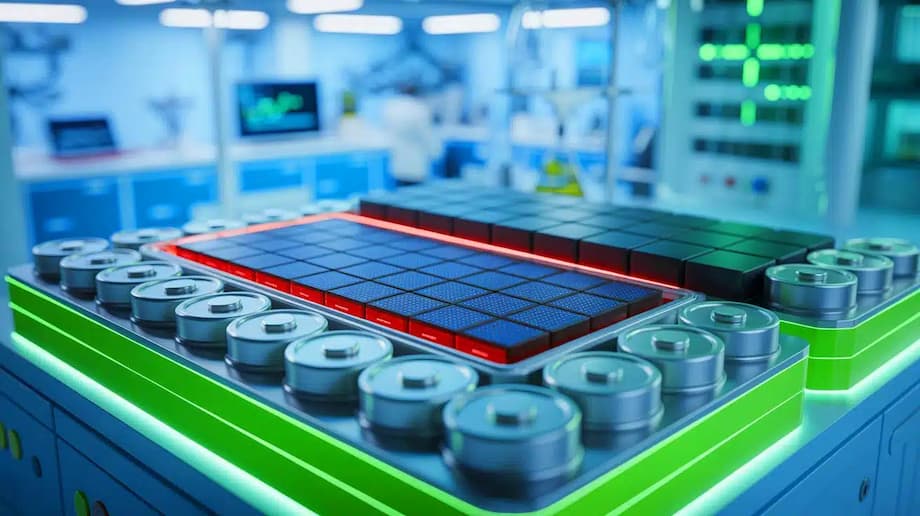A practical leap for sodium batteries
Researchers at Tokyo University of Science report a marked advance in sodium-ion batteries by adding small amounts of scandium to a layered sodium manganese oxide cathode. The tweak targets a stubborn cause of performance loss and delivers longer life in lab tests. In a coin type full cell, electrodes with about 8 percent scandium retained roughly 60 percent of their capacity after 300 charge and discharge cycles. The gain addresses a central weakness that has held back sodium systems from competing with lithium cells in many uses.
The appeal of sodium rests on basic geology and safety. Sodium is abundant and widely distributed, which reduces cost pressure and supply risk. It also avoids cobalt, a metal with price and ethical concerns. The tradeoff has been durability. The larger sodium ion can strain host materials, especially the manganese based layered oxides favored for high capacity. Those strains compound over time and erode performance.
The new study finds that scandium changes how one specific crystal form of the cathode evolves during cycling. The doped material keeps its structure more intact, shows fewer side reactions at the electrolyte interface, and tolerates moisture better during handling. The effect appears unique to the pairing of scandium with the so called P prime 2 polytype, a variant whose atomic layers distort in an ordered way. Results like these point to design rules that could stabilize other layered oxides as well.
What was holding sodium manganese oxide back
Layered sodium manganese oxides have long looked attractive for sodium-ion batteries. The P prime 2 form of Na2/3MnO2, in particular, can access high reversible capacity from the Mn3+ to Mn4+ redox couple. The catch is that cycle life often falls off quickly. After dozens or a few hundred cycles, capacity can drop as the crystal collapses and parasitic reactions build up at the particle surface.
The Jahn-Teller problem in plain terms
The main culprit is a phenomenon called the Jahn-Teller effect. When manganese in the +3 state appears during charge and discharge, electrons settle into orbitals that stretch some bonds and compress others. The atoms around manganese shift to accommodate, so the lattice distorts. If those distortions happen in a patchy way and keep changing, the material accumulates internal strain. Microcracks form, the orderly arrangement of atoms gives way, and sodium cannot move in and out as easily. The battery loses capacity and becomes less efficient.
Why the polytype matters
Layered oxides with the same chemical formula can stack their atomic planes in different patterns, known as polytypes. The P2 and P prime 2 versions of Na2/3MnO2 behave differently. In P2, distortions tend to be local and unpredictable. In P prime 2, distortions line up across many atoms in a cooperative pattern. That long range order can be an advantage if the host stays intact. The Tokyo team set out to see whether a suitable dopant could tip the balance toward stability in P prime 2 while avoiding the pitfalls seen in P2.
What the Tokyo team changed in the cathode
The researchers compared scandium doping in both P2 and P prime 2 forms of sodium manganese oxide and varied the scandium level. The standout result came from P prime 2 Na2/3[Mn1−xScx]O2 with x near 0.08. At this level, scandium reshaped how crystals grew, producing smaller particles and a more uniform microstructure. The material better preserved the cooperative distortion that defines P prime 2 rather than letting it devolve into disorder.
Tests pointed to several advantages from scandium. The doped cathode showed fewer reactions with the electrolyte, which limits the formation of resistive films that sap power. It also showed improved resistance to moisture, valuable during powder processing and cell assembly. Attempts to replace manganese with other trivalent metals did not deliver similar gains. That points to a particular fit between scandium’s size and charge and the way the P prime 2 lattice organizes itself.
The team also reported that a brief pre-cycling step, essentially conditioning the electrode, further improved capacity retention. The combined effect translated into a clear improvement in cycle life relative to undoped samples.
Professor Shinichi Komaba, who leads the work at Tokyo University of Science, summarized the tradeoff candidly.
Scandium is an expensive element, but our work demonstrates its potential to unlock long life sodium-ion batteries. The findings also suggest new design strategies for layered metal oxides beyond sodium systems.
The study was published in Advanced Materials and supported by national research programs in Japan. The focus was fundamental materials behavior, but the findings speak to practical needs in the battery industry.
How scandium stabilizes the P prime 2 structure
Scandium enters the manganese layer in small amounts and modifies the local environment of manganese ions. In P prime 2, the distortions of Mn3+ are not random. They organize into a honeycomb like pattern that repeats across the crystal. Scandium helps preserve this cooperative distortion. The result is a lattice that can breathe during charge and discharge without losing its overall registry. In effect, the material flexes in a predictable way rather than buckling and cracking.
At the same time, scandium changes particle morphology. Smaller, more uniform particles limit the distance sodium ions must travel inside the solid, easing transport. A cleaner interface forms with the electrolyte, which lowers the chance for parasitic reactions that consume active material. These effects compound to raise the odds that the cathode will keep working after many cycles.
The contrast with P2 is instructive. The same scandium addition does not deliver the same benefit in P2. Distortions there remain localized and the structure still drifts into less favorable states. The message for designers is that chemistry and crystal topology must be tuned together, not in isolation.
What the tests show
In full cell tests using a hard carbon anode, the scandium doped P prime 2 cathode retained about 60 percent of its initial capacity after 300 charge and discharge cycles. The electrodes kept their crystallinity better than undoped controls, and impedance growth was slower, which supports the observation of fewer harmful side reactions. Those are meaningful gains for a high capacity layered oxide in the sodium family.
Other research threads point in the same direction. In NASICON type cathodes, which differ from layered oxides, scandium has boosted both ionic and electronic pathways. For example, scandium doped Na3MnTi(PO4)3 improved conductivity and sodium ion mobility, with an optimized composition holding about 93 percent of its capacity after 250 cycles at a modest rate and about 88 percent after 500 cycles at a higher rate. A scandium modified Na3V2(PO4)2F3 with a carbon coating reached strong rate capability and high cycle retention, including about 90 percent after 1000 cycles at elevated current. Test protocols and metrics vary, so direct comparisons are not one to one. The common theme is that small scandium additions can stabilize structures and lower polarization across different families.
The detailed analysis of the layered oxide work, including the unique synergy between scandium and the cooperative distortion in P prime 2, is available in the peer reviewed literature. Readers can find an abstracted overview through PubMed at this entry.
Cost, supply and scaling for scandium
Scandium is scarce in concentrated form and usually produced as a by product from other mining and refining streams. Supply remains limited and is concentrated in a few countries. Recent export controls and broader geopolitical tensions have made planners more cautious about depending on single regions for critical inputs. Market prices for scandium oxide are commonly quoted in the hundreds of dollars per kilogram, which invites questions about cost when moving from lab to factory.
Two points help put the economics in context. First, the doping level is low. Replacing a few percent of manganese with scandium adds only a small mass fraction of the expensive element to the cathode, which can limit the bill of materials impact. Second, multiple routes exist to reduce scandium intensity. Researchers can target dopants to surface regions where they most improve the interface, combine small scandium additions with protective coatings, or seek dopant pairs that mimic scandium’s structural role. New projects in Australia, North America and other regions are working to bring by product scandium to market at higher volumes, which could ease both price and supply risk if demand rises.
Where sodium-ion could win first
Sodium-ion technology looks well suited to stationary energy storage, where cost, safety and longevity often matter more than maximum energy per kilogram. Grid connected batteries, behind the meter systems, and community storage do not need to meet the stringent weight limits of vehicles. A stabilized layered cathode with high capacity could reduce the amount of material per kilowatt hour and improve competitiveness. For applications that demand many thousands of cycles with minimal loss, NASICON based cathodes that tolerate very long cycling may also play a role.
Mobility markets are also moving. Several manufacturers have announced plans for sodium-ion cells in entry level vehicles and two wheelers. Lower temperature performance and charging behavior are active research areas. Gains in cathode stability, electrolyte design, and anode engineering will decide how far sodium can push into transport. A safer, less resource constrained option has clear value if performance keeps improving.
What to watch next
Scale up is the next test. The scandium doped material has been demonstrated in coin type full cells. The path to stacked pouch or prismatic formats requires uniform doping at large batch sizes, tight control of particle morphology, and compatibility with standard electrolyte blends and separators. Moisture tolerance is encouraging for manufacturing yield, but production lines will still need strict controls.
Materials discovery also continues. The scandium effect may inspire efforts to find less costly ions that achieve similar lattice tuning, or to engineer manganese site vacancies and ordering to preserve cooperative distortions without scandium. Electrolyte strategies that limit side reactions, such as higher salt concentration or additives that form robust interphases, can complement cathode design. Pairing the cathode with improved hard carbon or alternative anodes could raise initial efficiency and long term stability together.
The Bottom Line
- Tokyo University of Science researchers report that scandium doping in a P prime 2 layered sodium manganese oxide cathode delivers about 60 percent capacity retention after 300 cycles in a coin type full cell.
- The gain targets cycle fade driven by Jahn-Teller distortions, keeping the lattice ordered, reducing side reactions, and improving moisture tolerance.
- The effect is specific to the P prime 2 polytype and was not reproduced in P2 or with other trivalent dopants tested.
- Optimal performance in the study came near 8 percent scandium substitution on the manganese site.
- Related work shows scandium can also improve NASICON type cathodes by boosting conductivity and ion mobility, with strong cycle retention under varied test conditions.
- Scandium is costly and supply is concentrated, but the required amounts are small and new by product sources are under development.
- Stabilized sodium-ion cathodes strengthen the case for sodium in grid storage and entry level mobility, where cost and safety are priorities.
- Next steps include scaling to larger cells, refining electrolyte and anode pairings, and exploring lower cost dopant strategies inspired by scandium’s structural role.




